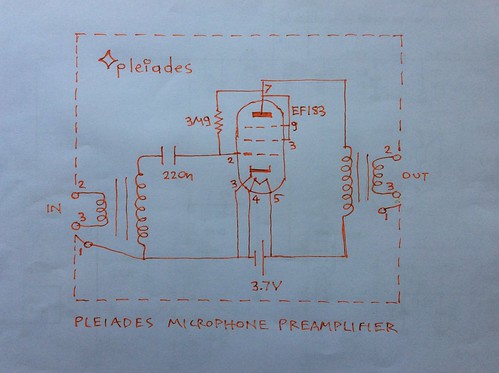This is the URL:
https://farm5.staticflickr.com/4262/35858046756_bbcd5097c5_k.jpg[/img

The Pleiades V6 is an electron tube ultra low noise microphone booster preamplifier having a single tube powered by just one li ion 3.7V battery (more attention is needed with li-ion batteries, 3x 1.2V NiMH are fine). Operation of the electron tube is in class A. Class A operation means by definition that electrons are flowing all the time. This achieves the lowest possible distortion for small signals. At large signals the Pleiades V6 may behave as a soft overload curve electron tube mastering amplifier, peak limiting at almost the speed of light.
The Pleiades V6 is designed to make a dynamic moving coil microphone or a ribbon microphone sound in real world at least as loud, sensitive or low noise as a condencer microphone. The output of this front end amplifier is to be connected to the input of a microphone preamplifier as one would connect a Neumann U47 microphone.
Circuit description or what each component does:
The low impedance microphone signal in the form of electrons dancing to the music is stepped up by the input transformer to a value comparable to that of a condenser microphone capsule. The coupling capacitor passes the signal but does not let the DC voltage assumed by the grid to be disturbed by the transformer. The battery supplies the heater with 3.7V. As the cathode is heated electrons boil off and the cathode becomes positive with respect to grid by the missing electrons. In other words the grid becomes negative wrt cathode. Electrons would be traped unable to travel to the low potential anode but the accelerating potential supplied by the 3.9 Megohm resistor from plate to grid frees electrons and make operation possible. The grid voltage is now close to O volts but still a little negative wrt cathode. The signal supplied by the capacitor (22nF is fine) can now be amplified as on electron tubes operating at much higher anode potential. The cathode is connected to ground and the negative terminal of the battery. The positive terminal of the 3.7V battery is connected to the anode through the primary of the output transformer with minimal voltage drop. The secondary of the output transformer brings us back to low impedance for connecting to the outside world. Electrons at the secondary output dance to the music at greater amplitudes and in a way that keeps frequency response flat to our brain, (see following paragraph). The tube is the EF183 vari mu high transconductance pentode, triode connected.
Bass compensation (reduction) for the proximity effect, Fletcher-Munson, voice effort curves can be built in by reducing the number of the transformer primary winding turns further simplifying the construction.
Suitable transformer cores are tape wound Nanoperm Nanocrystalinne ring cores by Magnetec. Input or output transformers can by correct choice of low turns compensate for the above effects and therefore create flat frequency responce from vocal chords of singer to listener's brain. This is the principle used in the Pleiades transformers. They also provide isolation, RF rejection, balanced and low impedance input and output. The input impedance of this electron tube in the Pleiades configuration at the grid terminal is typically 100ΚΩ. Normally nothing too elaborate should be used for the transformer windings. Just a symmetrical geometrically primary and secondary winding. Preferably one layer of each winding and the number of turns for full layer arranged by the thickness of the insulated wires used.
Cathode temperature can be optimized for maximum signal to noise ratio by adjusting the heater voltage. (Much like exoerimenting on the best temperature for baking amazing croissants made with butter and not vegetable or palm oil or palm fat having a reputation of clogging arteries).
The operation at a so low potential is made possible by not biasing the electron tube 2 times negatively, one internaly by nature and one by external components. Akowledgement to Hliana Stalika for insisting that the grid should not be negatively biased for freeing the electrons.
The anode to grid resistor counteracts the internal by nature negative bias. Resultant bias then becomes close to 0 but still negative. This allows the electron tube to have a normal transconductance at such a low anode potential.
The amplifier is extremely quiet, having virtualy no secondary electron emission effects at such low potential and temperature. The triode connected EF183 is deliberately underheated as is done on the VF14 electron tube of the Neumann U47 microphone.
Pleiades concepts or schematics are public domain.
References:
On preserving transconductance of electron tubes at anode potential as low as 3 volts - euroelectron blogspot
Operating features of the Audion - Edwin Howard Armstrong
"The Secret of Hollywood" - Sound Picture recording and reproducing characteristics - D.P. Loye, K.E. Morgan - Journal of society of motion picture engineers
US patent 1,349,252 - H. D. Arnold
Tubes vs Transistors, is there an audible difference? - Russel O. Hamm - Journal of the Audio Engineering Society
No comments:
Post a Comment